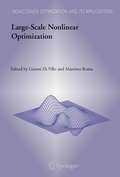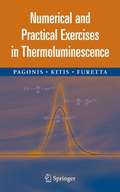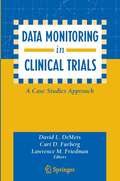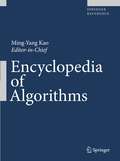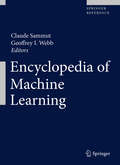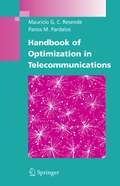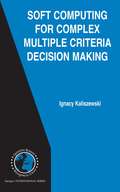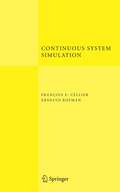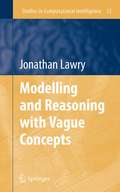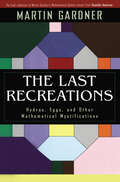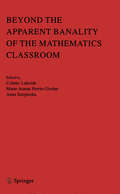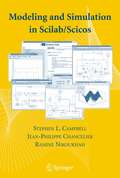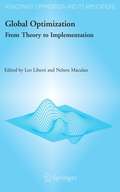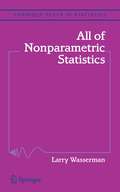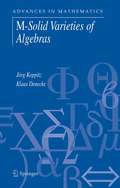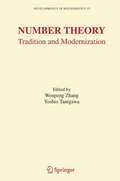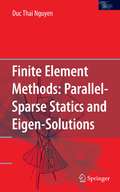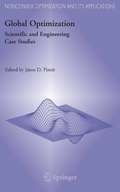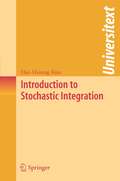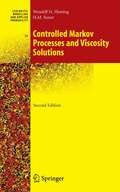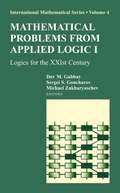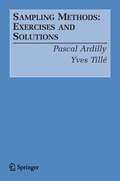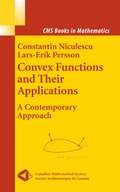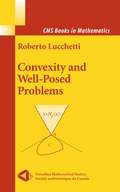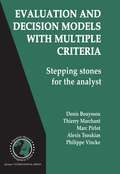- Table View
- List View
Large-Scale Nonlinear Optimization (Nonconvex Optimization and Its Applications #83)
by Gianni Pillo Massimo RomaThis book reviews and discusses recent advances in the development of methods and algorithms for nonlinear optimization and its applications, focusing on the large-dimensional case, the current forefront of much research. Individual chapters, contributed by eminent authorities, provide an up-to-date overview of the field from different and complementary standpoints, including theoretical analysis, algorithmic development, implementation issues and applications.
Numerical and Practical Exercises in Thermoluminescence
by Vasilis Pagonis George Kitis Claudio FurettaThermoluminescence (TL) is a well-established technique widely used in do- metric and dating applications. Although several excellent reference books exist which document both the t- oretical and experimental aspects of TL, there is a general lack of books that deal withspeci?cnumericalandpracticalaspectsofanalyzingTLdata. Manytimesthe practicaldetailsofanalyzingnumericalTLglowcurvesandofapplyingtheoretical models are dif?cult to ?nd in the published literature. The purpose of this book is to provide a practical guide for both established researchers and for new graduate students entering the ?eld of TL and is intended to be used in conjunction with and as a practical supplement of standard textbooks in the ?eld. Chapter1laysthemathematicalgroundworkforsubsequentchaptersbyprese- ingthefundamentalmathematicalexpressionsmostcommonlyusedforanalyzing experimental TL data. Chapter2presentscomprehensiveexamplesofTLdataanalysisforglowcurves following ?rst-, second-, and general-order kinetics. Detailed analysis of num- ical data is presented by using a variety of methods found in the TL literature, with particular emphasis in the practical aspects and pitfalls that researchers may encounter. Special emphasis is placed on the need to use several different me- ods to analyze the same TL data, as well as on the necessity to analyze glow curves obtained under different experimental conditions. Unfortunately, the lit- ature contains many published papers that claim a speci?c kinetic order for a TL peak in a dosimetric material, based only on a peak shape analysis. It is hoped that the detailed examples provided in Chapter 2 will encourage more comprehensive studies of TL properties of materials, based on the simultaneous use of several different methods of analysis.
Data Monitoring in Clinical Trials: A Case Studies Approach
by David L. DeMets Curt D. Furberg Lawrence M. FriedmanFrom the authors of "Fundamentals of Clinical Trials" which has sold over 15,000 copies world wide since its publication in 1998. No competition yet as the text does not focus on how to do clinical trials but on very specific situations that can be encountered during the process.
Encyclopedia of Machine Learning
by Claude Sammut and Geoffrey I. WebbThis comprehensive encyclopedia, with over 250 entries in an A-Z format, provides easy access to relevant information for those seeking entry into any aspect within the broad field of machine learning. Most entries in this preeminent work include useful literature references.Topics for the Encyclopedia of Machine Learning were selected by a distinguished international advisory board. These peer-reviewed, highly-structured entries include definitions, illustrations, applications, bibliographies and links to related literature, providing the reader with a portal to more detailed information on any given topic.The style of the entries in the Encyclopedia of Machine Learning is expository and tutorial, making the book a practical resource for machine learning experts, as well as professionals in other fields who need to access this vital information but may not have the time to work their way through an entire text on their topic of interest.The authoritative reference is published both in print and online. The print publication includes an index of subjects and authors. The online edition supplements this index with hyperlinks as well as internal hyperlinks to related entries in the text, CrossRef citations, and links to additional significant research.
Handbook of Optimization in Telecommunications
by Mauricio G. C. Resende Panos M. PardalosThis comprehensive handbook brings together experts who use optimization to solve problems that arise in telecommunications. It is the first book to cover in detail the field of optimization in telecommunications. Recent optimization developments that are frequently applied to telecommunications are covered. The spectrum of topics covered includes planning and design of telecommunication networks, routing, network protection, grooming, restoration, wireless communications, network location and assignment problems, Internet protocol, World Wide Web, and stochastic issues in telecommunications. The book’s objective is to provide a reference tool for the increasing number of scientists and engineers in telecommunications who depend upon optimization.
Soft Computing for Complex Multiple Criteria Decision Making (International Series in Operations Research & Management Science #85)
by Ignacy KaliszewskiThis book concentrates on providing technical tools to make the user of Multiple Criteria Decision Making (MCDM) methodologies independent of bulky optimization computations. These bulky computations have been a necessary, but limiting, characteristic of interactive MCDM methodologies and algorithms. The book removes these limitations of MCDM problems by reducing a problem's computational complexity. The result is a wider and more functional general framework for presenting, teaching, implementing and applying a wide range of MCDM methodologies.
Continuous System Simulation
by François E. Cellier Ernesto KofmanHighly computer-oriented text, introducing numerical methods and algorithms along with the applications and conceptual tools. Includes homework problems, suggestions for research projects, and open-ended questions at the end of each chapter. Written by our successful author who also wrote Continuous System Modeling, a best-selling Springer book first published in the 1991 (sold about 1500 copies).
Modelling and Reasoning with Vague Concepts (Studies in Computational Intelligence #12)
by Jonathan LawryThis volume introduces a formal representation framework for modelling and reasoning, that allows us to quantify the uncertainty inherent in the use of vague descriptions to convey information between intelligent agents. This can then be applied across a range of applications areas in automated reasoning and learning. The utility of the framework is demonstrated by applying it to problems in data analysis where the aim is to infer effective and informative models expressed as logical rules and relations involving vague concept descriptions. The author also introduces a number of learning algorithms within the framework that can be used for both classification and prediction (regression) problems. It is shown how models of this kind can be fused with qualitative background knowledge such as that provided by domain experts. The proposed algorithms will be compared with existing learning methods on a range of benchmark databases such as those from the UCI repository.
The Last Recreations: Hydras, Eggs, and Other Mathematical Mystifications
by Martin GardnerOf all of Martin Gardners writings, none gained him a wider audience or was more central to his reputation than his Mathematical Recreations column in Scientific American - which virtually defined the genre of popular mathematics writing for a generation. Flatland, Hydras and Eggs: Mathematical Mystifications is the final collection of these columns, covering the period roughly from 1979 to Gardners retirement in 1986. As always in his published collections, Gardner includes letters commenting on the ideas presented in his articles. These columns show him at the top of his form and should not be missed by anyone with an interest in mathematics.
Beyond the Apparent Banality of the Mathematics Classroom
by Colette Laborde Marie-Jeanne Perrin-Glorian Anna SierpinskaNew research in mathematics education deals with the complexity of the mathematics’ classroom. The classroom teaching situation constitutes a pertinent unit of analysis for research into the ternary didactic relationship which binds teachers, students and mathematical knowledge. The classroom is considered as a complex didactic system, which offers the researcher an opportunity to gauge the boundaries of the freedom that is left with regard to choices about the knowledge to be taught and the ways of organizing the students’ learning, while giveing rise to the study of interrelations between three main elements of the teaching process the: mathematical content to be taught and learned, management of the various time dimensions, and activity of the teacher who prepares and manages the class, to the benefit of the students' knowledge and the teachers' own experience. This volume, reprinted from Educational Studies in Mathematics, Volume 59, focuses on classroom situations as a unit of analysis, the work of the teacher, and is strongly anchored in original theoretical frameworks. The contributions are formulated from the perspective of one or more theoretical frameworks but they are tackled by means of empirical investigations.
Modeling and Simulation in Scilab/Scicos with ScicosLab 4.4
by Stephen L. Campbell Jean-Philippe Chancelier Ramine NikoukhahScilab and its Scicos block diagram graphical editor, with a special emphasis on modeling and simulation tools. The first part is a detailed Scilab tutorial, and the second is dedicated to modeling and simulation of dynamical systems in Scicos. The concepts are illustrated through numerous examples, and all code used in the book is available to the reader.
Global Optimization: From Theory to Implementation (Nonconvex Optimization and Its Applications #84)
by Leo Liberti Nelson MaculanMost global optimization literature focuses on theory. This book, however, contains descriptions of new implementations of general-purpose or problem-specific global optimization algorithms. It discusses existing software packages from which the entire community can learn. The contributors are experts in the discipline of actually getting global optimization to work, and the book provides a source of ideas for people needing to implement global optimization software.
All of Nonparametric Statistics (Springer Texts in Statistics)
by Larry WassermanThis text provides the reader with a single book where they can find accounts of a number of up-to-date issues in nonparametric inference. The book is aimed at Masters or PhD level students in statistics, computer science, and engineering. It is also suitable for researchers who want to get up to speed quickly on modern nonparametric methods. It covers a wide range of topics including the bootstrap, the nonparametric delta method, nonparametric regression, density estimation, orthogonal function methods, minimax estimation, nonparametric confidence sets, and wavelets. The book’s dual approach includes a mixture of methodology and theory.
M-Solid Varieties of Algebras (Advances in Mathematics #10)
by Jörg Koppitz Klaus DeneckeA complete and systematic introduction to the fundamentals of the hyperequational theory of universal algebra, offering the newest results on solid varieties of semirings and semigroups. The book aims to develop the theory of solid varieties as a system of mathematical discourse that is applicable in several concrete situations. A unique feature of this book is the use of Galois connections to integrate different topics.
Number Theory: Tradition and Modernization (Developments in Mathematics #15)
by Wenpeng Zhang Yoshio TanigawaThis book collects survey and research papers on various topics in number theory. Although the topics and descriptive details appear varied, they are unified by two underlying principles: first, readability, and second, a smooth transition from traditional approaches to modern ones. Thus, on one hand, the traditional approach is presented in great detail, and on the other, the modernization of the methods in number theory is elaborated.
Finite Element Methods: Parallel-Sparse Statics and Eigen-Solutions
by Duc Thai NguyenFinite element methods (FEM), and its associated computer software have been widely accepted as one of the most effective general tools for solving large-scale, practical engineering and science applications. For implicit finite element codes, it is a well-known fact that efficient equation and eigen-solvers play critical roles in solving large-scale, practical engineering/science problems. Sparse matrix technologies have been evolved and become mature enough that all popular, commercialized FEM codes have already inserted sparse solvers into their software. However, a few FEM books have detailed discussions about Lanczos eigen-solvers, or explain domain decomposition (DD) finite element formulation (including detailed hand-calculator numerical examples) for parallel computing purposes. The materials from this book have been evolved over the past several years through the author's research work, and graduate courses.
Global Optimization: Scientific and Engineering Case Studies (Nonconvex Optimization and Its Applications #85)
by János D. PintérOptimization models based on a nonlinear systems description often possess multiple local optima. The objective of Global Optimization (GO) is to find the best possible solution of multiextremal problems. This volume illustrates the applicability of GO modeling techniques and solution strategies to real-world problems. Coverage extends to a broad range of applications, from agroecosystem management to robot design. Proposed solutions encompass a range of practical and viable methods.
Introduction to Stochastic Integration (Universitext)
by Hui-Hsiung KuoAlso called Ito calculus, the theory of stochastic integration has applications in virtually every scientific area involving random functions. This introductory textbook provides a concise introduction to the Ito calculus. From the reviews: "Introduction to Stochastic Integration is exactly what the title says. I would maybe just add a ‘friendly’ introduction because of the clear presentation and flow of the contents." --THE MATHEMATICAL SCIENCES DIGITAL LIBRARY
Controlled Markov Processes and Viscosity Solutions (Stochastic Modelling and Applied Probability #25)
by Wendell H. Fleming Halil Mete SonerThis book is an introduction to optimal stochastic control for continuous time Markov processes and the theory of viscosity solutions. It covers dynamic programming for deterministic optimal control problems, as well as to the corresponding theory of viscosity solutions. New chapters in this second edition introduce the role of stochastic optimal control in portfolio optimization and in pricing derivatives in incomplete markets and two-controller, zero-sum differential games.
Mathematical Problems from Applied Logic I: Logics for the XXIst Century (International Mathematical Series #4)
by Dov M. Gabbay Michael Zakharyaschev Sergei S. GoncharovThis is an overview of the current state of knowledge along with open problems and perspectives, clarified in such fields as non-standard inferences in description logics, logic of provability, logical dynamics and computability theory. The book includes contributions concerning the role of logic today, including unexpected aspects of contemporary logic and the application of logic. This book will be of interest to logicians and mathematicians in general.
Sampling Methods: Exercises and Solutions
by Pascal Ardilly Yves TilléWhenweagreedtoshareallofourpreparationofexercisesinsamplingtheory to create a book, we were not aware of the scope of the work. It was indeed necessary to compose the information, type out the compilations, standardise the notations and correct the drafts. It is fortunate that we have not yet measured the importance of this project, for this work probably would never have been attempted! In making available this collection of exercises, we hope to promote the teaching of sampling theory for which we wanted to emphasise its diversity. The exercises are at times purely theoretical while others are originally from real problems, enabling us to approach the sensitive matter of passing from theory to practice that so enriches survey statistics. The exercises that we present were used as educational material at the École Nationale de la Statistique et de l’Analyse de l’Information (ENSAI), where we had successively taught sampling theory. We are not the authors of all the exercises. In fact, some of them are due to Jean-Claude Deville and Laurent Wilms. We thank them for allowing us to reproduce their exercises. It is also possible that certain exercises had been initially conceived by an author that we have not identi?ed. Beyondthe contribution of our colleagues, and in all cases, we do not consider ourselves to be the lone authors of these exercises:they actually form part of a common heritagefrom ENSAI that has been enriched and improved due to questions from students and the work of all the demonstrators of the sampling course at ENSAI.
Convex Functions and their Applications: A Contemporary Approach (CMS Books in Mathematics)
by Constantin Niculescu Lars-Erik PerssonThorough introduction to an important area of mathematics Contains recent results Includes many exercises
Convexity and Well-Posed Problems (CMS Books in Mathematics)
by Roberto LucchettiThis book deals mainly with the study of convex functions and their behavior from the point of view of stability with respect to perturbations. We shall consider convex functions from the most modern point of view: a function is de?ned to be convex whenever its epigraph, the set of the points lying above the graph, is a convex set. Thus many of its properties can be seen also as properties of a certain convex set related to it. Moreover, we shall consider extended real valued functions, i. e. , functions taking possibly the values?? and +?. The reason for considering the value +? is the powerful device of including the constraint set of a constrained minimum problem into the objective function itself (by rede?ning it as +? outside the constraint set). Except for trivial cases, the minimum value must be taken at a point where the function is not +?, hence at a point in the constraint set. And the value ?? is allowed because useful operations, such as the inf-convolution, can give rise to functions valued?? even when the primitive objects are real valued. Observe that de?ning the objective function to be +? outside the closed constraint set preserves lower semicontinuity, which is the pivotal and mi- mal continuity assumption one needs when dealing with minimum problems. Variational calculus is usually based on derivatives.
Evaluation and Decision Models with Multiple Criteria: Stepping stones for the analyst (International Series in Operations Research & Management Science #86)
by Denis Bouyssou Thierry Marchant Marc Pirlot Alexis Tsoukias Philippe VinckeFormal decision and evaluation models are so widespread that almost no one can pretend not to have used or suffered the consequences of one of them. This book is a guide aimed at helping the analyst to choose a model and use it consistently. A sound analysis of techniques is proposed and the presentation can be extended to most decision and evaluation models as a "decision aiding methodology".
